Estimation of the Mean Trace Length of Discontinuities in an Underground Drift Using Laser Scanning Point Cloud Data
Abstract
1. Introduction
2. Discontinuity Mapping
3. Mean Trace Length Estimation
4. Sampling Windows Set in 3DM
5. Comparison of the Two Sampling Methods on the Simulated Case
5.1. Simulated Case
5.2. Results
6. Case Study
7. Conclusions
- Based on the drift point cloud data obtained using 3D laser scanning, the discontinuities in the drift were extracted, and the virtual sampling windows were laid out in the 3DM using 3DEC software. Then, a method to analyze the mean trace length using the 3DM was proposed.
- The 3DM was divided into three areas: the roof and both sides. According to the principle of the best area coverage and the largest sampling window size, the size of the rectangular sampling window was arranged according to the area size, and circular sampling windows were continuously arranged with an interval of radius r. Using 3DEC, the mean trace length estimation results of two different sampling windows in the 3DM were compared and analyzed. The results showed that the error value of the mean trace length obtained using the circular measurement window was smaller, and its estimated result was closer to the true value of the trace length.
- Using the mean trace length estimation method proposed in the study, the mean trace length of a discontinuity was estimated in the selected area of drift No. 5 at the 1300 m level of Jianshan Underground Mine in Panzhihua, Sichuan, China. The results indicated that the mean trace length in the study area was 1.28 m.
- In this study, 3DEC software was utilized to estimate the mean trace length using a 3DM. In subsequent research, this software can also be used for DFN generation, block instability analyses, and rock support analyses. Moreover, the mean trace length estimation method used in this research can provide an effective basic data extraction method for follow-up research.
Author Contributions
Funding
Institutional Review Board Statement
Informed Consent Statement
Data Availability Statement
Conflicts of Interest
References
- Kong, D.; Saroglou, C.; Wu, F.; Sha, P.; Li, B. Development and application of UAV-SfM photogrammetry for quantitative characterization of rock mass discontinuities. Int. J. Rock Mech. Min. Sci. 2021, 141, 104729. [Google Scholar] [CrossRef]
- Singh, S.K.; Raval, S.; Banerjee, B.P. Automated structural discontinuity mapping in a rock face occluded by vegetation using mobile laser scanning. Eng. Geol. 2021, 285, 169–175. [Google Scholar] [CrossRef]
- Zheng, J.; Deng, J.; Yang, X.; Wei, J.; Zheng, H.; Cui, Y. An improved Monte Carlo simulation method for discontinuity orientations based on Fisher distribution and its program implementation. Comput. Geotech. 2014, 61, 266–276. [Google Scholar] [CrossRef]
- ISRM. Suggested methods for the quantitative description of discontinuities in rock masses. Int. J. Rock Mech. Min. Sci. Geomech. Abstr. 1978, 15, 319–368. [Google Scholar] [CrossRef]
- Chen, S.; Walske, M.L.; Davies, I.J. Rapid mapping and analysing rock mass discontinuities with 3D terrestrial laser scanning in the underground excavation. Int. J. Rock Mech. Min. Sci. 2018, 110, 28–35. [Google Scholar] [CrossRef]
- Fekete, S.; Diederichs, M. Integration of three-dimensional laser scanning with discontinuum modelling for stability analysis of tunnels in blocky rockmasses. Int. J. Rock Mech. Min. Sci. 2013, 57, 11–23. [Google Scholar] [CrossRef]
- Havaej, M.; Coggan, J.; Stead, D.; Elmo, D. A Combined Remote Sensing–Numerical Modelling Approach to the Stability Analysis of Delabole Slate Quarry, Cornwall, UK. Rock Mech. Rock Eng. 2015, 49, 1227–1245. [Google Scholar] [CrossRef]
- Xu, W.; Zhang, Y.; Li, X.; Wang, X.; Ma, F.; Zhao, J.; Zhang, Y. Extraction and statistics of discontinuity orientation and trace length from typical fractured rock mass: A case study of the Xinchang underground research laboratory site, China. Eng. Geol. 2020, 269, 54–69. [Google Scholar] [CrossRef]
- Lyman, G.J. Rock fracture mean trace length estimation and confidence interval calculation using maximum likelihood methods. Int. J. Rock Mech. Min. Sci. 2003, 40, 825–832. [Google Scholar] [CrossRef]
- Zhang, L.Y.; Ding, X.B. Variance of non-parametric rock fracture mean trace length estimator. Int. J. Rock Mech. Min. Sci. 2010, 47, 1222–1228. [Google Scholar] [CrossRef]
- Sturzenegger, M.; Stead, D. Close-range terrestrial digital photogrammetry and terrestrial laser scanning for discontinuity characterization on rock cuts. Eng. Geol. 2009, 106, 163–182. [Google Scholar] [CrossRef]
- Sturzenegger, M.; Stead, D. Quantifying discontinuity orientation and persistence on high mountain rock slopes and large landslides using terrestrial remote sensing techniques. Nat. Hazards Earth Syst. Sci. 2009, 9, 267–287. [Google Scholar] [CrossRef]
- Sturzenegger, M.; Stead, D.; Elmo, D. Terrestrial remote sensing-based estimation of mean trace length, trace intensity and block size/shape. Eng. Geol. 2011, 119, 96–111. [Google Scholar] [CrossRef]
- Wei, X.; Guo, Y.; Cheng, M.; Wei, J.; Zhang, L.; Huo, L.; Hou, Z. Estimation of Fracture Geometry Parameters and Characterization of Rock Mass Structure for the Beishan Area, China. Acta Geol. Sin.-Engl. Ed. 2020, 94, 1381–1392. [Google Scholar] [CrossRef]
- Umili, G.; Ferrero, A.; Einstein, H. A new method for automatic discontinuity traces sampling on rock mass 3D model. Comput. Geosci. 2013, 51, 182–192. [Google Scholar] [CrossRef]
- Zhang, Q.; Wang, Q.; Chen, J.; Li, Y.; Ruan, Y. Estimation of mean trace length by setting scanlines in rectangular sampling window. Int. J. Rock Mech. Min. Sci. 2016, 84, 74–79. [Google Scholar] [CrossRef]
- Cacciari, P.P.; Futai, M.M. Mapping and characterization of rock discontinuities in a tunnel using 3D terrestrial laser scanning. Bull. Eng. Geol. Environ. 2015, 75, 223–237. [Google Scholar] [CrossRef]
- Cacciari, P.P.; Futai, M.M. Modeling a Shallow Rock Tunnel Using Terrestrial Laser Scanning and Discrete Fracture Networks. Rock Mech. Rock Eng. 2017, 50, 1217–1242. [Google Scholar] [CrossRef]
- Cacciari, P.P.; Futai, M.M. The Influence of Fresh and Weathered Rock Foliation on the Stability of the Monte Seco Tunnel. Rock Mech. Rock Eng. 2020, 54, 537–558. [Google Scholar] [CrossRef]
- Battulwar, R.; Zare-Naghadehi, M.; Emami, E.; Sattarvand, J. A state-of-the-art review of automated extraction of rock mass discontinuity characteristics using three-dimensional surface models. J. Rock Mech. Geotech. Eng. 2021, 13, 920–936. [Google Scholar] [CrossRef]
- Ge, Y.; Tang, H.; Xia, D.; Wang, L.; Zhao, B.; Teaway, J.W.; Chen, H.; Zhou, T. Automated measurements of discontinuity geometric properties from a 3D-point cloud based on a modified region growing algorithm. Eng. Geol. 2018, 242, 44–54. [Google Scholar] [CrossRef]
- Li, X.; Chen, Z.; Chen, J.; Zhu, H. Automatic characterization of rock mass discontinuities using 3D point clouds. Eng. Geol. 2019, 259, 105131. [Google Scholar] [CrossRef]
- Monsalve, J.J.; Baggett, J.; Bishop, R.; Ripepi, N. Application of laser scanning for rock mass characterization and discrete fracture network generation in an underground limestone mine. Int. J. Min. Sci. Technol. 2019, 29, 131–137. [Google Scholar] [CrossRef]
- Kulatilake, P.H.S.W.; Wu, T.H. The Density of Discontinuity Traces in Sampling Windows. Int. J. Rock Mech. Mtn. Sci. Geomech. Abstr. 1984, 21, 345–347. [Google Scholar] [CrossRef]
- Mauldon, M. Estimating Mean Fracture Trace Length and Density from Observations in Convex Windows. Rock Mech. Rock Eng. 1998, 31, 201–216. [Google Scholar] [CrossRef]
- Itasca. 3DEC V 7.0, Minneapolis. 2019. Available online: https://www.itascacg.com/software/downloads/3dec-7-00-update (accessed on 22 October 2022).
- Wu, Q.; Kulatilake, P.H.S.W.; Tang, H. Comparison of rock discontinuity mean trace length and density estimation methods using discontinuity data from an outcrop in Wenchuan area, China. Comput. Geotech. 2011, 38, 258–268. [Google Scholar] [CrossRef]
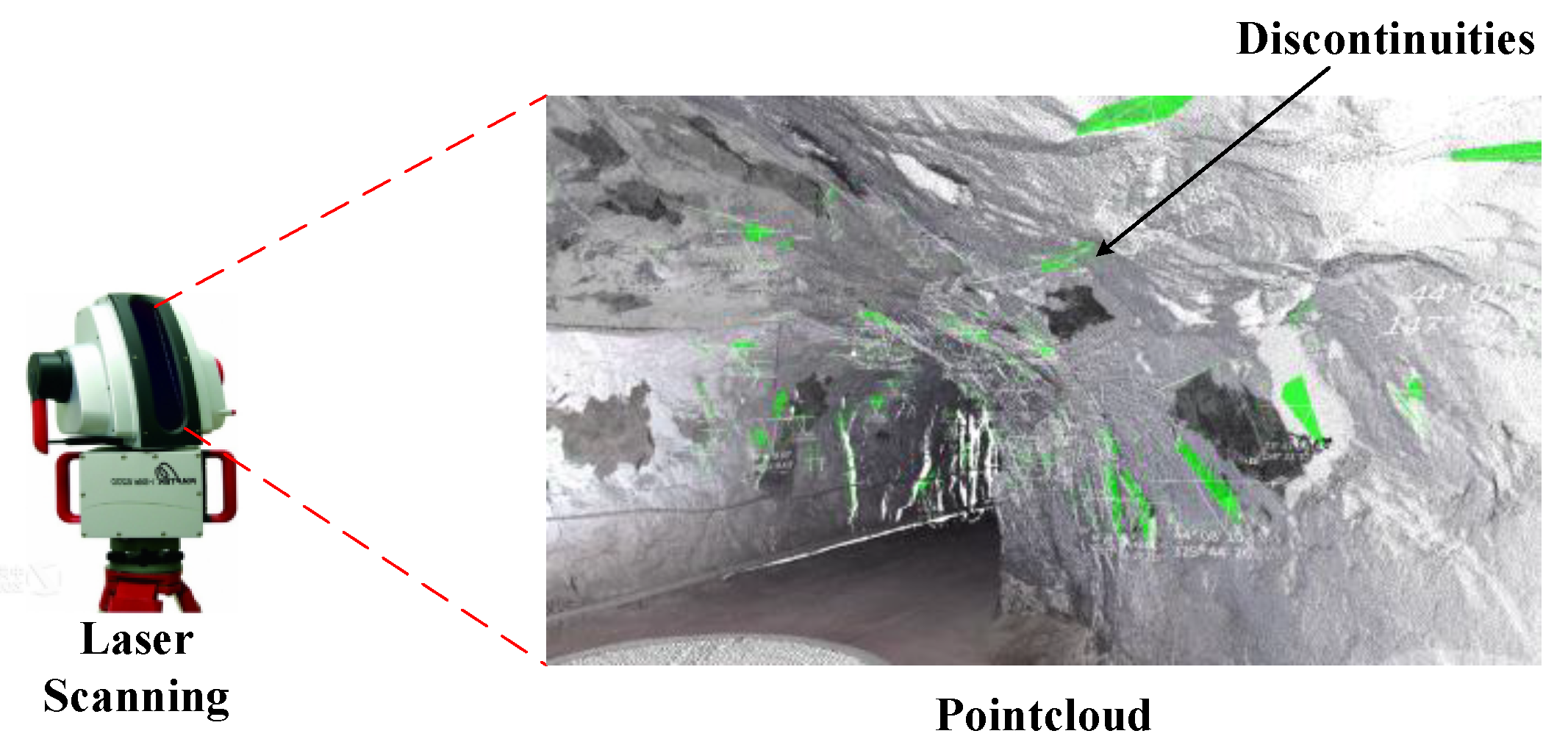


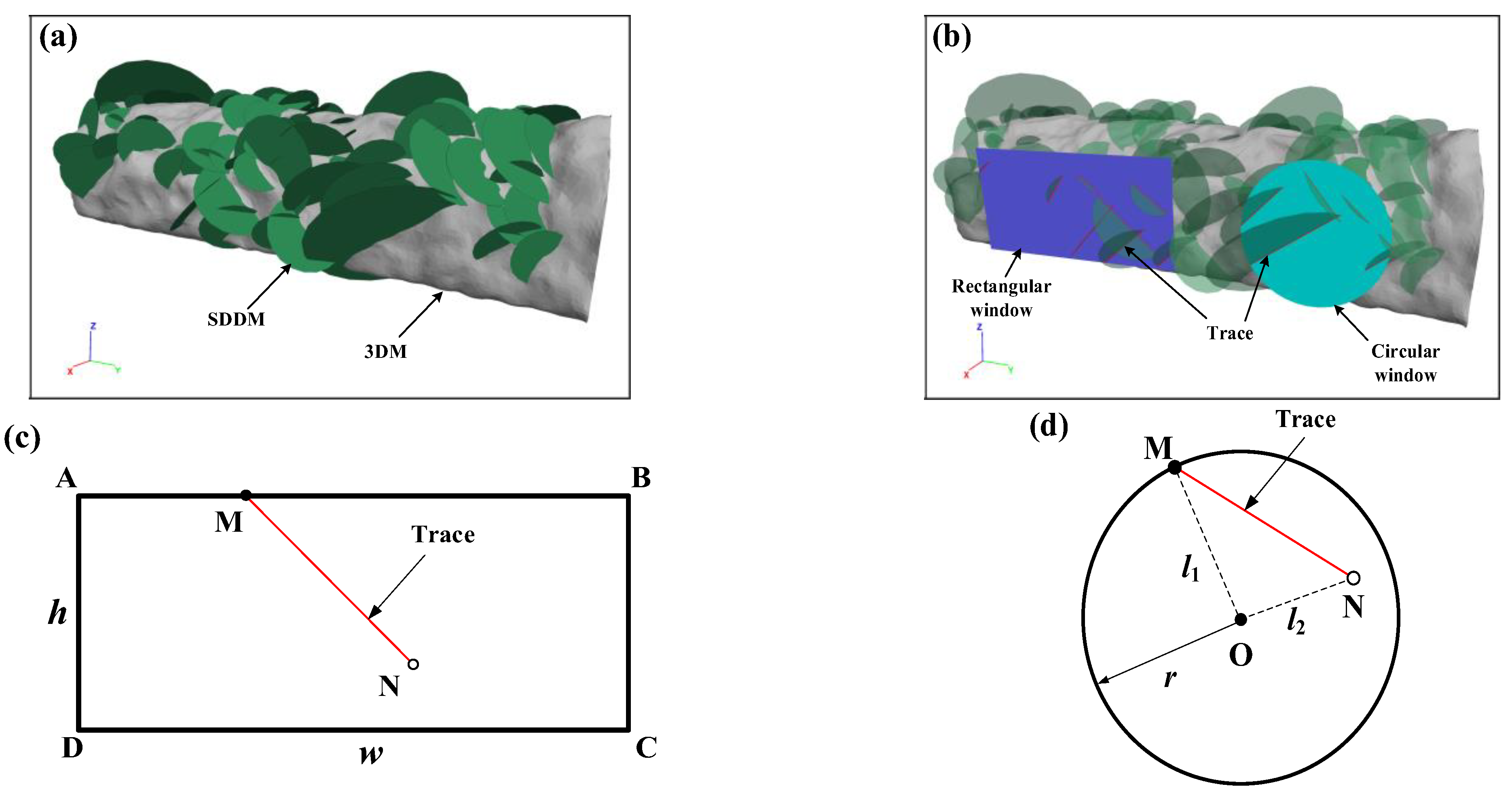

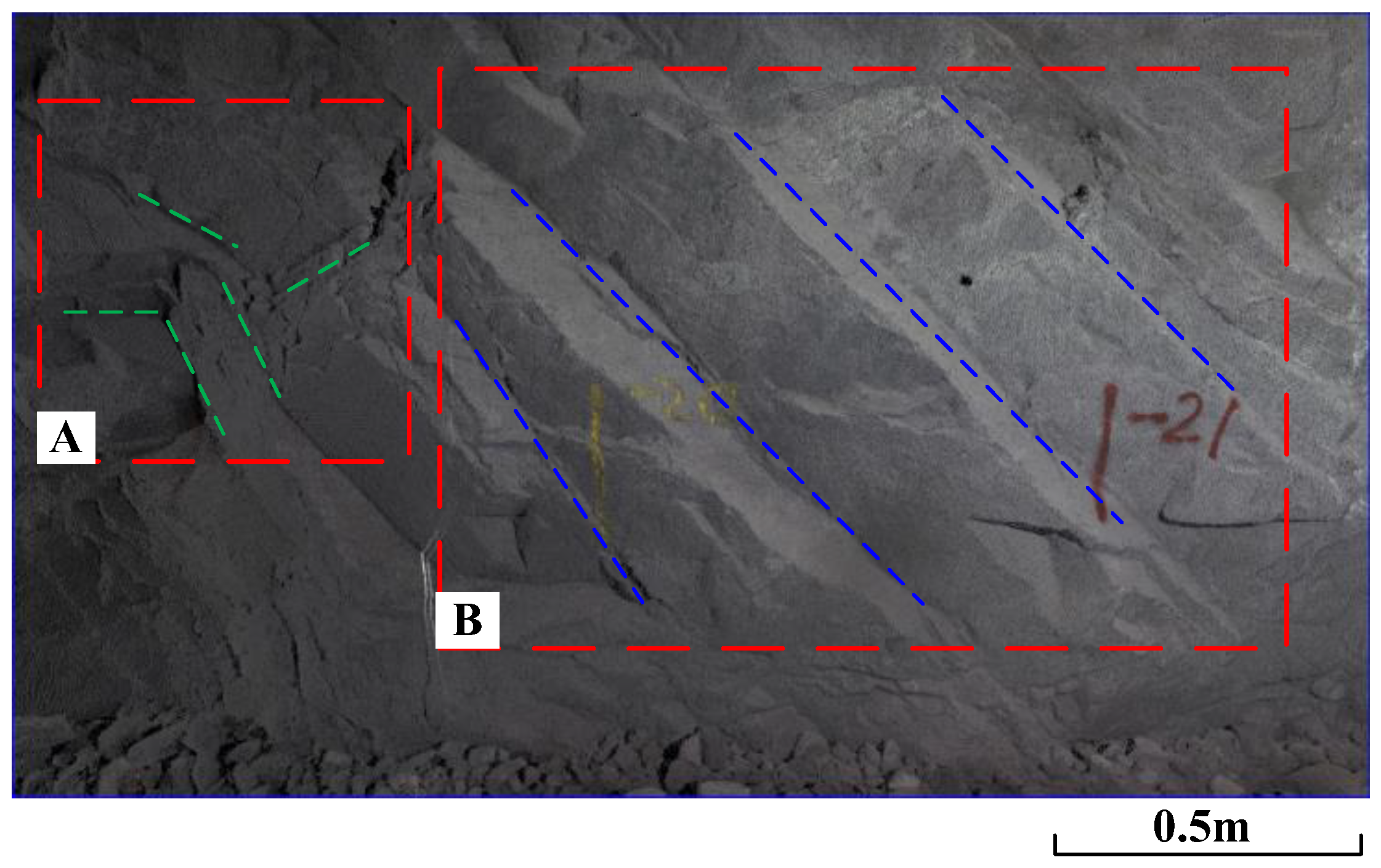
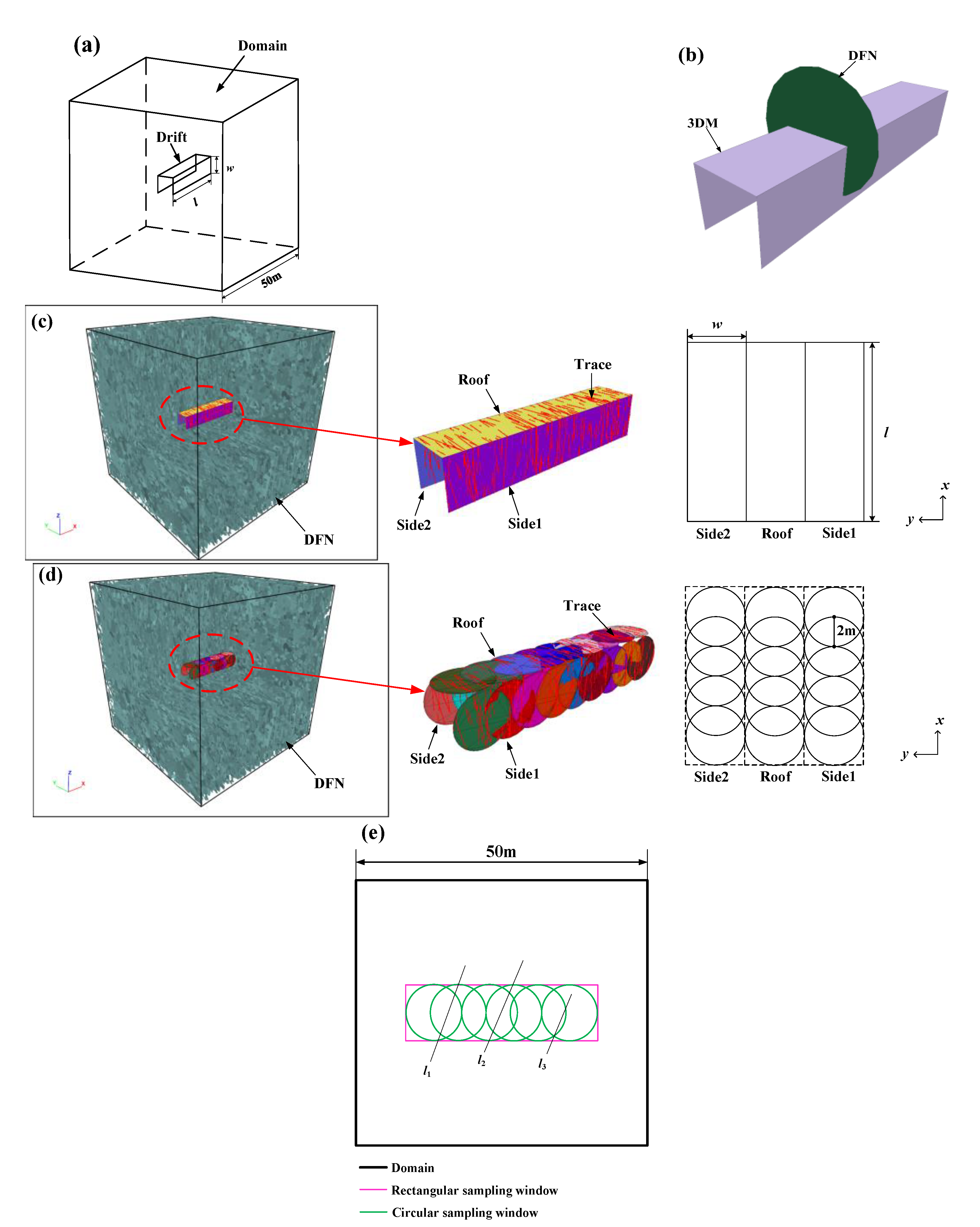
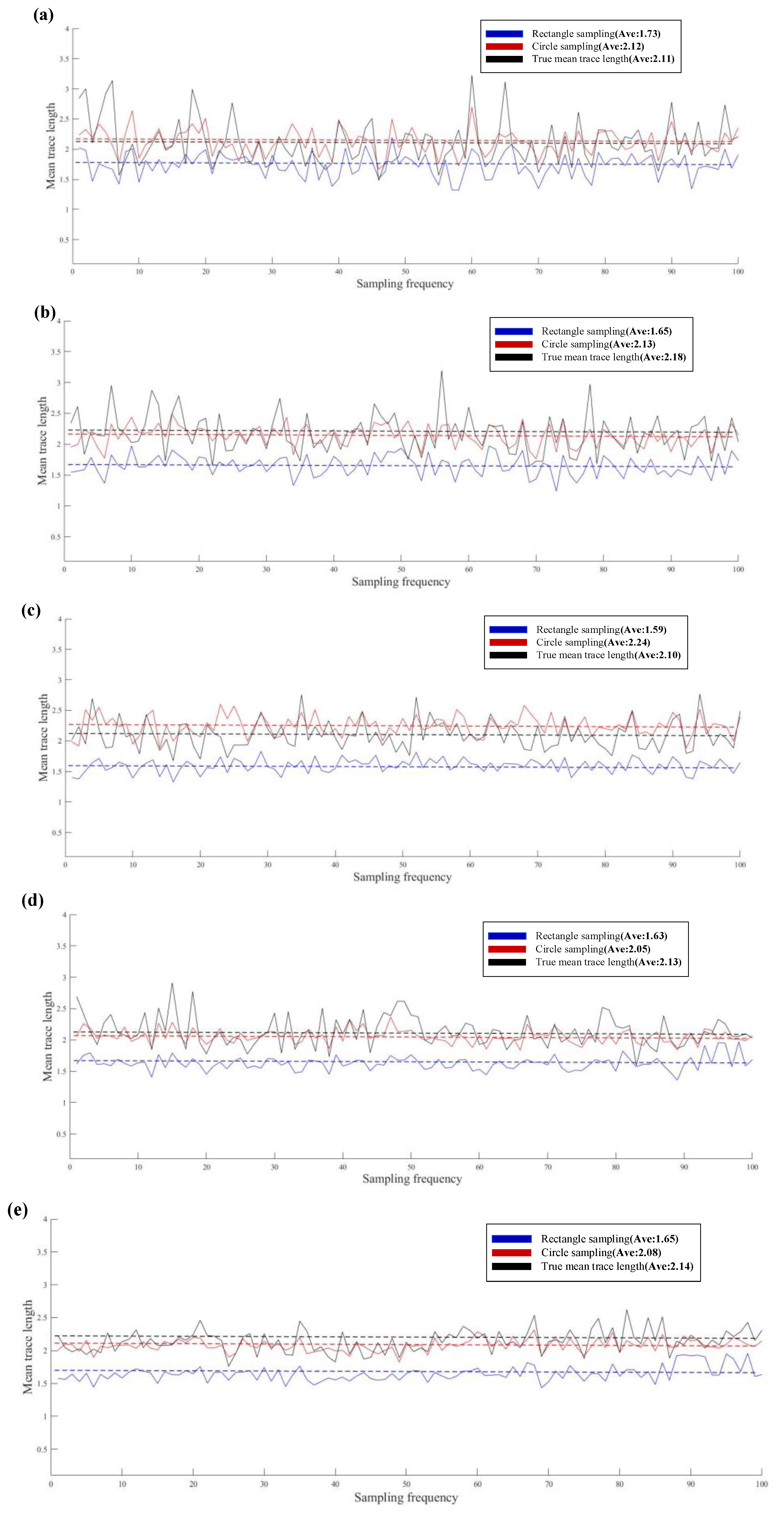
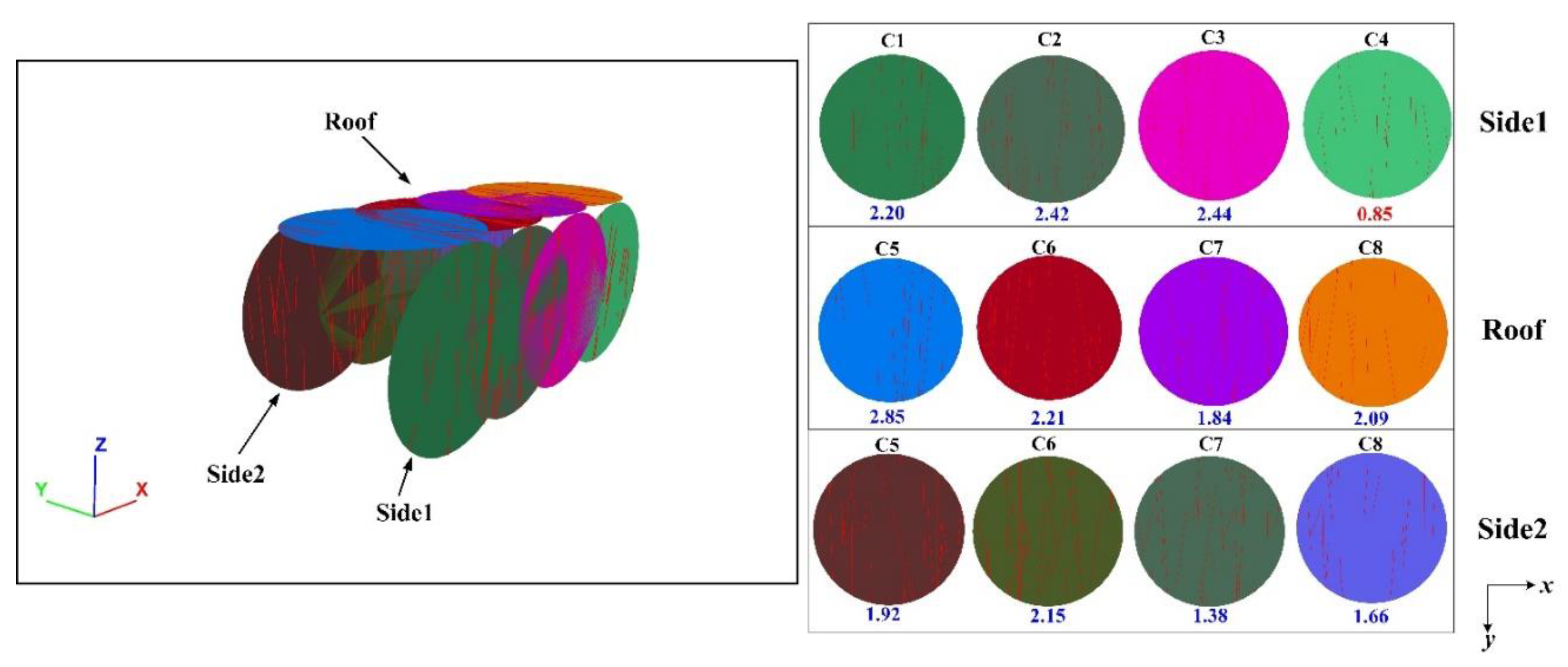

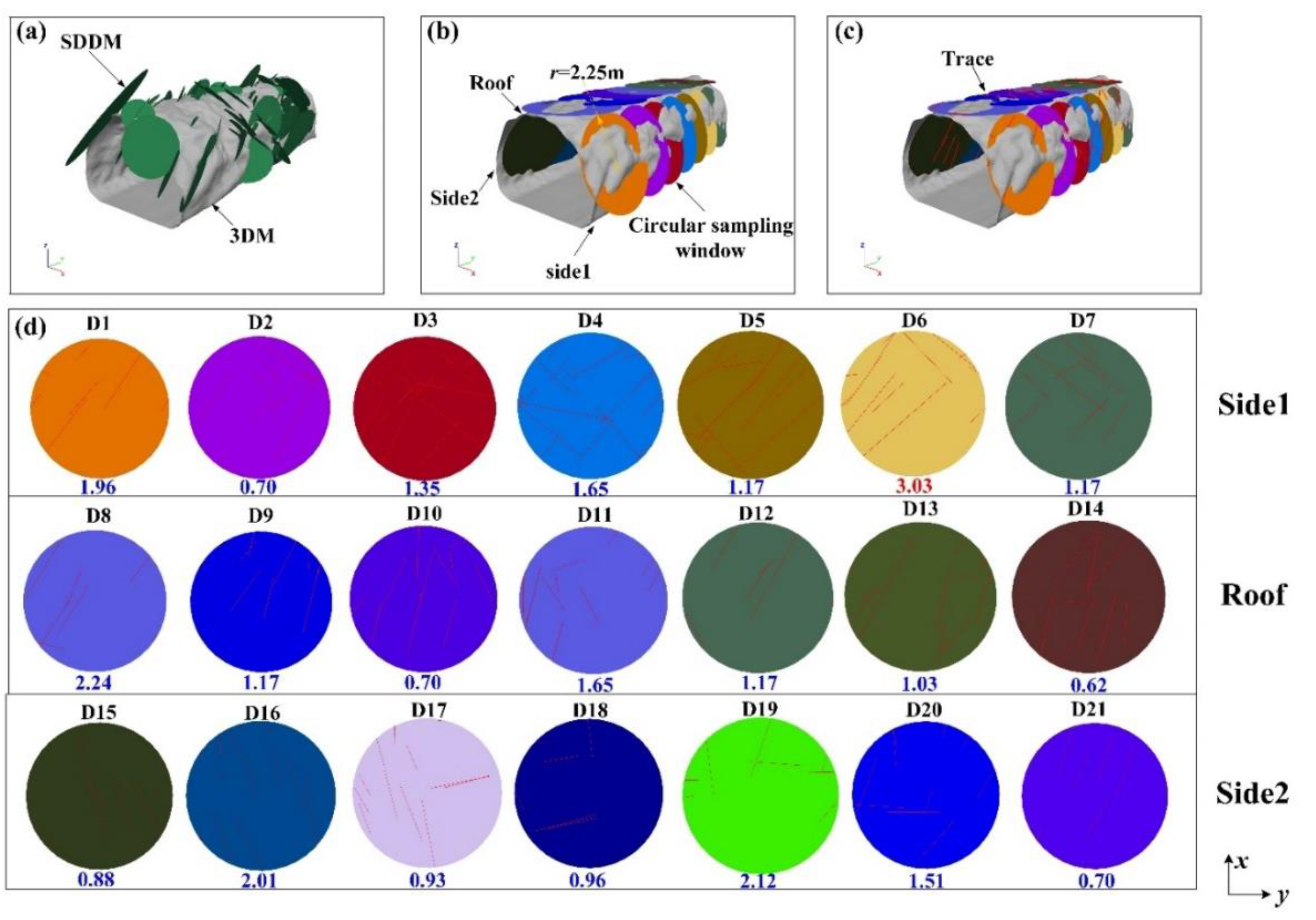
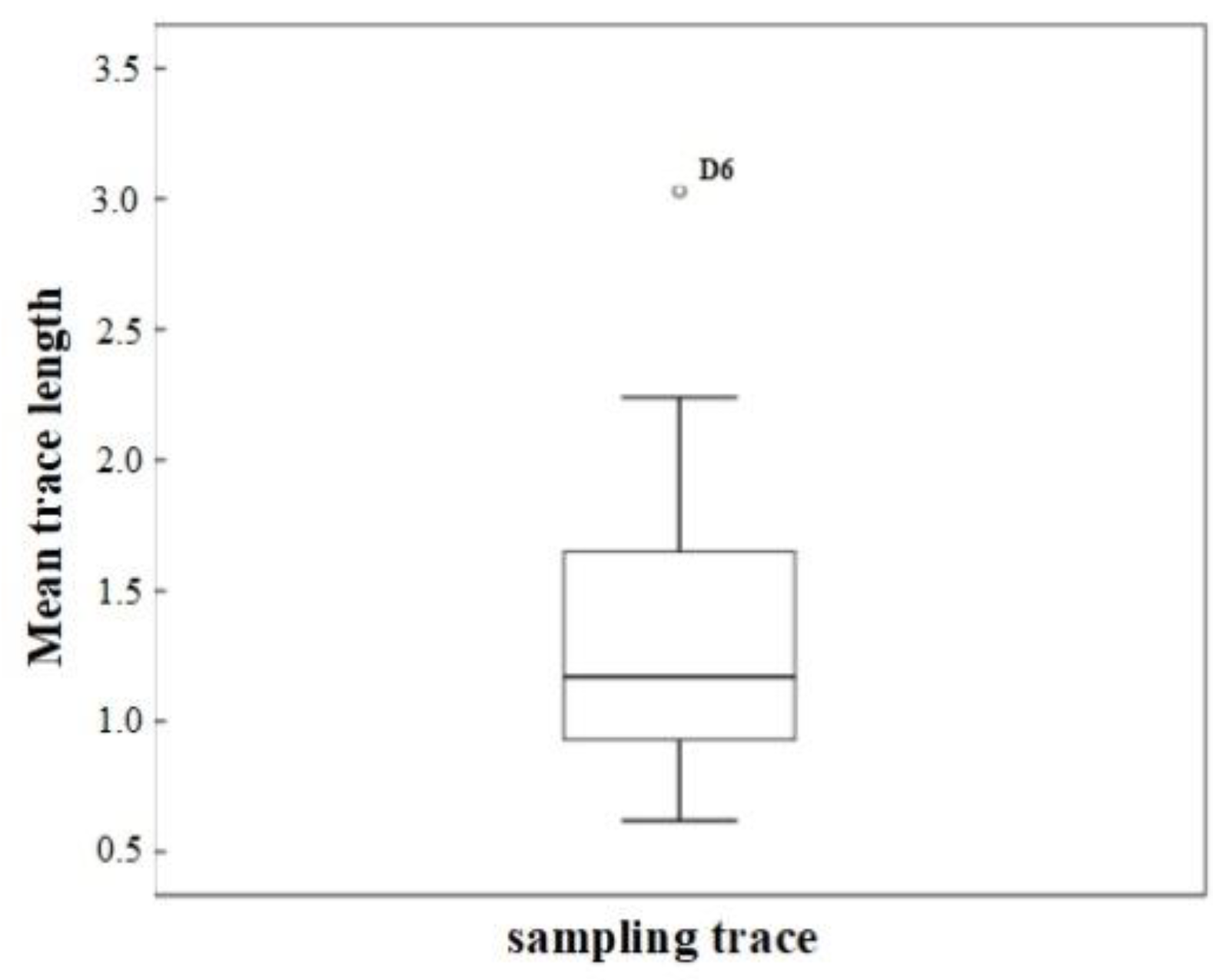
| Drift Length | Sampling Times | Average Relative Error (Rectangular Sampling Window) | Average Relative Error (Circular Sampling Window) |
|---|---|---|---|
| 10 m | 100 | 17.49% | 11.01% |
| 20 m | 100 | 23.18% | 9.64% |
| 30 m | 100 | 23.31% | 10.65% |
| Number of Discontinuities | Sampling Times | Average Relative Error (Rectangular Sampling Window) | Average Relative Error (Circular Sampling Window) |
|---|---|---|---|
| 100,000 | 100 | 23.18% | 9.64% |
| 200,000 | 100 | 22.99% | 7.56% |
| 300,000 | 100 | 22.69% | 5.42% |
Publisher’s Note: MDPI stays neutral with regard to jurisdictional claims in published maps and institutional affiliations. |
© 2022 by the authors. Licensee MDPI, Basel, Switzerland. This article is an open access article distributed under the terms and conditions of the Creative Commons Attribution (CC BY) license (https://creativecommons.org/licenses/by/4.0/).
Share and Cite
Xiao, Y.; Yang, C.; Li, J.; Zhou, K.; Lin, Y.; Sun, G. Estimation of the Mean Trace Length of Discontinuities in an Underground Drift Using Laser Scanning Point Cloud Data. Sustainability 2022, 14, 15650. https://doi.org/10.3390/su142315650
Xiao Y, Yang C, Li J, Zhou K, Lin Y, Sun G. Estimation of the Mean Trace Length of Discontinuities in an Underground Drift Using Laser Scanning Point Cloud Data. Sustainability. 2022; 14(23):15650. https://doi.org/10.3390/su142315650
Chicago/Turabian StyleXiao, Yigai, Chengye Yang, Jielin Li, Keping Zhou, Yun Lin, and Guoquan Sun. 2022. "Estimation of the Mean Trace Length of Discontinuities in an Underground Drift Using Laser Scanning Point Cloud Data" Sustainability 14, no. 23: 15650. https://doi.org/10.3390/su142315650
APA StyleXiao, Y., Yang, C., Li, J., Zhou, K., Lin, Y., & Sun, G. (2022). Estimation of the Mean Trace Length of Discontinuities in an Underground Drift Using Laser Scanning Point Cloud Data. Sustainability, 14(23), 15650. https://doi.org/10.3390/su142315650








